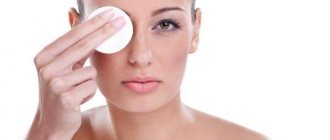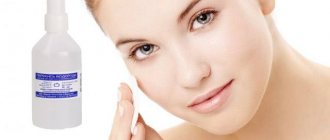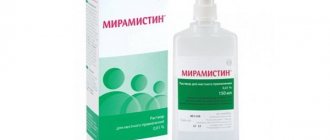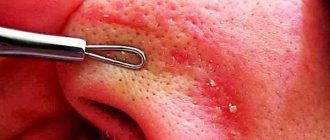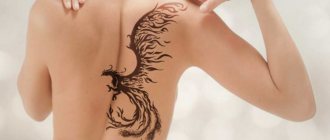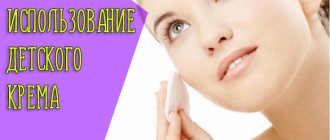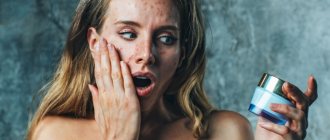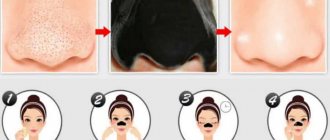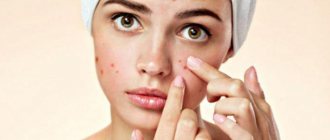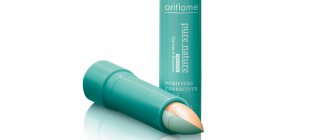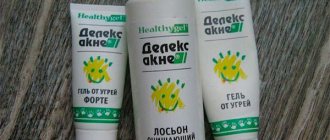The substance chlorhexidine and its salts (chlorhexidine hydrochloride, chlorhexidine digluconate, chlorhexidine diacetate) is included in cosmetic products and personal care products, such as facial cosmetics, hair dyes, soaps, and mouth rinses.
This compound is added as a cosmetic antiseptic, preservative or disinfectant. The substance has a strong bactericidal effect. There are often recommendations to use it against acne, but reviews about its use in this capacity are contradictory, and it has contraindications.
Description and composition, where to buy, price
Chlorhexidine is an organic compound with antimicrobial properties that acts against bacteria, viruses and fungi. Externally, chlorhexidine looks like an odorless white or pale yellow powder and is poorly soluble in water and most organic solvents.
Due to the poor solubility of chlorhexidine in water, salts of chlorhexidine and glucuronic acid (gluconate, diluconate), hydrochloric acid (hydrochloride) or acetic acid (acetate) are mainly used. Chlorhexidine gluconate is highly soluble in water and alcohol.
Concentrated chlorhexidine gluconate is a colorless or pale yellow, odorless solution with a bitter taste. Aqueous solutions of chlorhexidine salts exhibit maximum biological activity and chemical stability at a solution pH of 5 to 8.
Chlorhexidine gluconate as an antiseptic is used in concentrations from 0.5 to 4%. It is registered in the European Union Commission database (Cosmetic Ingredient Database) and can be used as a cosmetic preservative in a concentration of no more than 0.3%.
Chlorhexidine hydrochloride is included in tablets for sore throats and is used to disinfect catheters and as a preservative in creams, ointments and gels. Chlorhexidine acetate is used to disinfect equipment, surfaces and textiles, and is used to make antacids.
The most commonly used is chlorhexidine gluconate.
This compound was first synthesized in 1954 by ICI Pharmaceuticals. Chlorhexidine has been shown to have high antimicrobial activity, low toxicity to body cells, and is well tolerated by the skin and mucous membranes. Therefore, chlorhexidine has become widely used as an antimicrobial agent for topical use.
Hand disinfectants when used on intact skin contain 4% chlorhexidine digluconate, and antiseptics for damaged skin contain 1%.
In obstetric procedures, drugs containing 1% chlorhexidine are used; in dentistry, 0.2% chlorhexidine is included in mouth rinses; oral gels containing 1% chlorhexidine are also used.
Preparations containing chlorhexidine:
| A drug | price, rub. |
| Chlorhexidine bigluconate 0.05%, 100 ml, Samaramedprom, Russia | 55 |
| Chlorhexidine bigluconate 0.05%, SFF, 100 ml Samara factory | 84 |
| Chlorhexidine 0.5% 1 l, Rosbio | 169 |
| Chlorhexidine 0.05% 100 ml, Biogen | 15 |
| Chlorhexidine 0.5% alcohol, spray | 22 |
| 911 skin antiseptic with chlorhexidine, 0.3% | 45 |
Skin interaction
Chlorhexidine is a cationic surfactant with a broad spectrum of antibacterial activity; it also acts against fungi, but to a lesser extent. It destroys the membranes of microbial cells and coagulates their cytoplasmic proteins. At pH 5-8, chlorhexidine salts dissociate, resulting in the formation of a positively charged chlorhexidine cation.
This cation binds to the negatively charged bacterial cell wall. Chlorhexidine inhibits cell membrane enzymes and disrupts the interaction of lipids and proteins in membranes, the bacterial cell membrane becomes permeable and the cell contents leak out.
At higher concentrations of chlorhexidine (more than 0.01%), cytoplasmic proteins coagulate, denature, and the bacterial cell dies. Mold cells are destroyed by the same mechanism. At high concentrations, chlorhexidine destroys the virus envelope.
The effect of chlorhexidine lasts for several hours. It is non-toxic in low concentrations and does not irritate the skin.
Chlorhexidine applied to the facial skin for 8-12 weeks significantly reduces the amount of acne. An ointment containing chlorhexidine gluconate as an active substance reduces the formation of comedones. Acne occurs due to dysfunction of the sebaceous glands and excessive secretion of oily skin secretions.
If the disease is accompanied by hyperkeratosis, in which epidermal cells do not exfoliate regularly enough, then comedones are formed. Skin secretions are a breeding ground for bacteria, including Propionibacterium acnes. Bacteria multiply in closed pores and cause inflammation.
Antibacterial agents, which include chlorhexidine, act against bacterial flora, so inflammation is reduced. But these remedies do not treat the causes of acne, which explains the negative reviews about its use.
Some dermatologists also recommend using chlorhexidine to treat the skin of the face and body to treat acne. Other experts believe that chlorhexidine is toxic and should only be used when the benefits outweigh its harmful effects. Chlorhexidine against acne on the back and shoulders: the product is quite effective, since the skin in these areas is less sensitive.
Chlorhexidine is used to eliminate inflammation on the face.
Chlorhexidine for the face (consumer reviews of its use as an anti-acne product, both negative and positive) is more suitable for skin with intense secretion, that is, for oily skin or combination skin. On skin with insufficient sebum production and sensitive skin, chlorhexidine often causes peeling and irritation.
Patient reviews
I have very problematic and sensitive skin. It is very difficult to choose a cream; it happens that inappropriate products provoke rashes. On the advice of a cosmetologist, I purchased Chlorhexidine. Using the solution in just a few days relieves inflammation and evens out the skin. And most importantly, I use it after professional cleansing and peeling at home. After these procedures, I often get white pustules, which is extremely unpleasant. Chlorhexidine removes them in a couple of treatments.
Oksana
Since childhood, I have not been able to get rid of the habit of squeezing out pimples and blackheads. After home cleaning there is always severe redness; before, even traces remained in the place where the acne was. I started using Chlorhexidine to avoid the spread of bacteria and prevent inflammation. This really works. I rub it on my skin before and after cleansing. There is no redness afterwards, and the skin has become much cleaner.
Natalia
When, due to problems with hormones, a rash began to constantly appear on my face, I smeared my skin with Chlorhexidine instead of toner in the morning and evening.
The product dried out the pimples perfectly, and they no longer appeared. I advise you to use a good nourishing cream after using an antiseptic, because at first I neglected it and my skin became dry. After I started applying cream to it, the peeling disappeared. Olga
Advantages and disadvantages
The product can be used in a wide range of pH values, works effectively in organic liquids, such as pus, and also:
- Chlorhexidine not only prevents bacterial growth upon contact, but also has a delayed-release effect, meaning it inhibits bacterial growth for several hours after application.
- Chlorhexidine for hand skin disinfection: at a concentration of 4%, a single use destroys 80-90% of bacteria.
- Using chlorhexidine in the mouth prevents the formation of plaque. A single rinse with 0.2% chlorhexidine reduces the number of bacteria in the mouth by 80-95%.
- Used as a preservative and protects cosmetics from contamination.
- Chlorhexidine gluconate is toxic when taken orally and when inhaled. But according to Cosmetic Ingredient Review (CIR) experts, chlorhexidine and its salts are safe in the concentrations used in cosmetics. These concentrations are 0.14% based on chlorhexidine; 0.19% based on chlorhexidine diacetate; 0.20% in terms of chlorhexidine digluconate; 0.16% - for chlorhexidine dihydrochloride. It is also known that chlorhexidine does not cause cancer and is not toxic to the reproductive system.
But there are also disadvantages to using chlorhexidine:
- Chlorhexidine can cause irritation and dry skin in some cases.
- Antibacterial agents destroy, among other things, the beneficial microflora of the skin, which can destroy its protective barrier. Hand cleansing with chlorhexidine reduces the number of microorganisms on the skin by 86-92%, including normal skin microflora.
- Long-term use of antibacterial agents can lead to the microflora becoming resistant to these substances.
- Chlorhexidine for the face (reviews from dermatologists are rather negative), according to reviews from dermatologists, is toxic. There is a high risk of damage to the middle ear and cornea of the eyes.
- The skin becomes more sensitive to UV radiation.
- When used in dentistry, a change in the color of the enamel and the appearance of tartar are noted.
Indications for use
Chlorhexidine digluconate is used in medical practice to disinfect the surface of the skin of patients before surgery, the surface of wounds, sterilization of surgical instruments and treatment of the skin of the hands of medical personnel. For these purposes, a 1% chlorhexidine solution is used.
A 2% solution is used to treat sexually transmitted diseases, infections of the genitourinary system, and for disinfection in gynecology.
Chlorhexidine for the oral cavity: at a concentration of 0.3% it prevents the appearance of plaque and stomatitis. Rinsing and irrigation help against candidiasis and gingivitis. Chlorhexidine for the face (reviews from consumers and dermatologists are similar) can be used to treat acne, although manufacturers do not indicate this method of use in the instructions.
Salicylic acid
The active ingredient of salicylic acid is the active component of willow bark. Many years ago, the drug was used in the treatment of rheumatism and some types of diathesis. Today, salicylic acid is the basis for the production of some medications.
The drug has a mild antiseptic and anti-inflammatory effect and is used to treat some skin diseases. It is used externally and is available in the form of an ointment and an alcohol solution.
Use for acne and blackheads
Before treating skin rashes with chlorhexidine, you should consult a dermatologist. To treat acne, it is recommended to add chlorhexidine to dry cosmetic masks, make compresses on certain areas of the face, and also wipe the face with a solution of chlorhexidine digluconate.
Compresses:
- Moisten a small piece of cloth, cotton swab or pad with 0.05% chlorhexidine solution.
- Make an application on the face for 3-5 minutes.
- After the compress, you need to wash your face with warm water and apply moisturizer.
- Do not reuse the cotton pad or swab.
Wiping:
- To prepare the solution, mix 0.05% chlorhexidine solution with chamomile extract in a 1:2 ratio.
- Wipe your face 1-2 times a day for 1-2 weeks.
- Wash with water and apply moisturizing sunscreen.
Is it possible to apply an antiseptic to the skin of the face?
The facial area is not protected by clothing; it is constantly exposed to aggressive environmental influences: temperature changes, humidity, and sun exposure.
Hormonal and physiological ailments of a person also affect the skin of the face, weakening its barrier function. Thus, skin with weakened protective properties cannot cope with the attack of microbes and viruses, and foci of inflammation occur - acne.
Many women wonder whether it is possible to wipe their face with chlorhexidine. The action of the product is based on its disinfectant properties. The area affected by microorganisms is treated with chlorhexidine .
The drug penetrates deeply into the dermis without losing its disinfectant properties even in a humid environment (with purulent and bloody discharge), destroys bacteria and viruses in the treated area, and prevents their further spread and reproduction. Thus, by treating the skin with medicine, the infected tissues are healed and the inflammatory process stops .
Masks
Face masks that help treat acne are different from regular skin-moisturizing masks. To eliminate acne, the best masks are those that absorb excess oils, draw out impurities from the skin's pores and restore balance. After using the mask, the skin looks fresher.
Antibacterial ingredients are also added to the masks, such as charcoal, green tea or a few drops of chlorhexidine. When using masks, the size of comedones is reduced, and the removal of excess fat and impurities prevents the appearance of acne in the future.
Masks can be used 1-2 times a week for 15-30 minutes.
- Mix a mixture of bodyaga powder and cosmetic white clay with a 0.05% chlorhexidine solution. Ratio of mask components: 2 volumes of clay powder, one volume of bodyaga powder.
- Apply the product for 15 minutes. Then rinse with warm water.
- After using the mask, it is recommended to use sunscreen creams.
With cosmetic clay
To treat acne, a peeling agent based on chlorhexidine and blue or black cosmetic clay is used. Cosmetic clay has beneficial properties, it contains minerals and can cleanse the skin.
When choosing the type of cosmetic clay, you need to consider your skin type. The frequency of the procedure also depends on the skin type: for oily and combination skin, it is recommended to do the mask 2-3 times a week, for dry skin - no more than once a week.
- Dilute the clay powder with water to the consistency of a thick paste.
- Mix the mixture with chlorhexidine in a 1:1 ratio.
- Apply the product to your face and massage for several minutes.
- Rinse off the composition with warm water.
Chlorhexidine vs cleansers
During the period of using an antiseptic for therapeutic or prophylactic purposes, it is better to avoid washing with soap. It is also undesirable to use products containing sodium lauryl sulfate and sodium carboxymethylcellulose. These chemicals greatly dry out the skin. If chlorhexidine is applied after them, the upper layers of the epidermis will become dehydrated. It is better to purchase cosmetics that do not contain these substances.
With essential oils
To prepare lotion for facial skin:
- Add 3-4 drops of essential oil to a 0.01% chlorhexidine solution.
- You can use any essential oil, but it is better to use oils that have antibacterial properties, such as tea tree or sandalwood.
- The oil does not mix well with chlorhexidine solution, so this mixture must be shaken well before use.
Daily use of chlorhexidine can cause negative effects on the skin of the face. With frequent use of antibacterial agents, bacteria mutate into strains that are resistant to these agents, and in the future, antibacterial agents no longer have a positive effect.
Frequent use of chlorhexidine also has negative reviews due to excessive sebum production. It is recommended to use chlorhexidine no more than 2-3 times a week, or take a course of treatment for 2-3 weeks and then take a break. Since chlorhexidine may cause allergic reactions in rare cases, you should consult a dermatologist before using it.
List of contraindications
Although the product has a mild effect, it still has contraindications. These include the following factors:
- seborrheic, contact and atopic dermatitis;
- eczema in active phase;
- the period of waiting for a child and breastfeeding;
- hypersensitivity;
- individual intolerance to the drug;
- excessive dry skin;
- age up to 12 years.
Rarely, side effects may occur: a feeling of tightness, itching, peeling, and the appearance of new pimples. In order to avoid such effects, you should use a nourishing or moisturizing cream suitable for the patient's skin type. While using Chlorhexidine, you should not sunbathe or visit a solarium. The skin becomes extremely sensitive.
